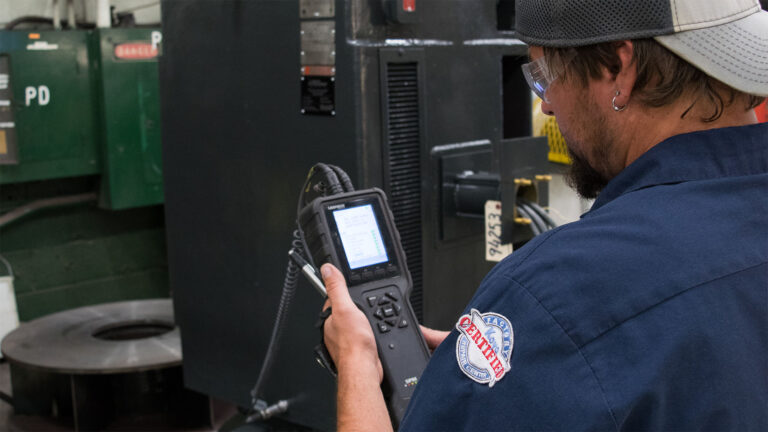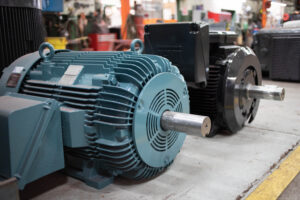
What equipment monitor your electric motor?
If your place of business follows a preventative or predictive maintenance program, you know the importance of closely monitoring all aspects of your equipment to prevent failure. In this article we will review a few of the many ways you can monitor your electric motor to predict faults or failures before they happen in order to prevent unscheduled down time.
Infrared Cameras
Infrared cameras, which used to be very costly but have dropped in price considerably in recent years, are one of the best tools to prevent electrical arcing, provide for safe and easy detection of loose connections, overloaded circuits, overheating motors, etc. A quick infrared scan is the best evaluation available for the prevention of electrical fires and explosions.
Vibration Analysis
Changes in motor vibration readings provide the best early warning of developing problems in the motor. The most common mechanical test for periodic and predictive maintenance is vibration analysis using a Fast-Fourier Transform (FFT) spectrum analyzer. FFT converts vibration data into vibration spectra, which then allows you to monitor any changes from your established baseline, and fix the problem before it becomes a bigger problem down the road. For horizontal motors, the readings are usually taken radially in the horizontal and vertical planes of both bearings, and axially at a minimum of one bearing housing.
Shock Pulse Method
Shock pulse uses amplification, filtering, and conversion of data to readable pulses to give you an idea of the conditions of your bearings. Shock pulse gives you two readings to work with: carpet value and max value. Carpet value gives you an idea of the lubrication condition, when lubrication begins to breakdown the carpet value will increase. The increase shows that the bearing is starting to experience more metal strikes in a given time frame. Max value gives you an idea of current bearing damage. As a defect in the bearing is hit with a ball or roller it creates a high amplitude burst of shock pulse waves. As bearing damage increases, max value increases.
Insulation Resistance (IR) Test
Overtime the insulation in your motor will begin to breakdown. IR testing can give you an idea of the health of you insulation at any given time. Your insulation is said to be in good condition if the resistance measured is greater than or equal to 10MΩ. Minimum insulation resistance for your motor (R) can be calculated by multiplying the rated voltage (Un), with the constant factor (0.5 Megohm/kV).
R = 0.5 x Un
To measure the resistance, a DC voltage of 500 – 1000V is applied between the windings and the ground of a motor by a high resistance range ohmmeter while the motor is offline.
Dielectric Absorption Ratio (DAR) Test
This is an extension of the IR test. IR testing is a spot test of a given moment in time. DAR testing is done over the course of up to ten minutes. The idea behind this test is that the IR should increase over time as the atoms in the insulation are polarized by the IR tester’s applied DC voltage. The IR measurements are taken after 30 and 60 seconds for each measurement. The equation for DAR is seen below:

Where R60 and R30 are the IR test measurements at 60 seconds and 30 seconds respectively. DAR measurements of <1.25 are considered questionable, ≤1.6 are adequate, and >1.6 are good.
Winding Resistance Measurements
To check for high-resistance connections or possible misconnections, you should periodically measure the winding resistance between leads with a bridge or digital low-resistance ohmmeter. Winding resistance testers apply a known DC current through the windings, measure the resulting voltage drop across the winding, and calculate the resistance. You should not apply more than 10% of the winding current rating; this will warm up the winding and create a changing resistance as the metal heats up.
Winding Inductance & Capacitance Measurements
Specialized test equipment can compare inductance and capacitance between pairs of winding leads to check for any unbalance. Although there are no industry acceptance standards for unbalance, manufacturer’s manuals offer some guidance.
Motor Current Signature Analysis
This test diagnoses rotor problems by detecting rotor currents induced into the stator windings and comparing the amplitude of 2X slip frequency side bands with the center frequency of 50 or 60 Hz. A clamp-on current transformer on the motor leads or CT control leads provide a signal for display on the spectrum analyzer, typically an FFT vibration analyzer. For the test to be effective, the applied load must provide sufficient slip to separate the side and from the center frequency. MCSA manufacturer’s manuals provide guidance on test interpretation. This test is effective in showing issues with power, stator faults, rotor faults, and air gaps.
HighPot and Surge Testing
High potential tests assess the condition of the motor’s insulation system by applying above rated voltage (overpotential) to the windings. Overpotential tests could cause a winding fault and result in downtime, so they shouldn’t be part of your predictive maintenance program. Although these tests usually do not damage sound windings, they could cause electrically weakened windings to fail on test or shortly afterward. Never use overpotential tests without a back-up plan.
Surge testing follows the same basic principles of high potential testing, but surge testing is done to find turn-to-turn insulation weakness. Some motor maintenance experts argue that surge testing is unnecessary and causes more issues than it solves. Surge testing is done by applying a fast rise-time, high voltage pulse to the winding, which can produce a voltage difference between close loops of wire. If the insulation is damaged between the two loops an arc will form between the two wires. This will show up in your surge waveform as two different waveform patterns. A healthy motor will only show one.
This article is based on our EMC Webinar: Getting the Most out of Your Electric Motor
Got More Motor Questions? We Can Help!
Call 800-595-5315 Or Connect With Our Expert Technicians Here:
Other Articles
- How to Reduce Motor Downtime and Keep Your Motor Happy
- Critical Spare Planning
- The Three Most Common Externally Caused Motor Failures

Gary has 30+ years of experience at Energy Management Corporation working in all aspects of motor and mechanical repairs. In his extensive career, some of the interesting projects he has worked on include Hoover Dam hydro generators, Utah power sub stations, harmonic filters for VFDs, and motor for the Buckeye Bullet that set the land speed record for electric car.





